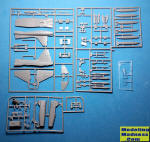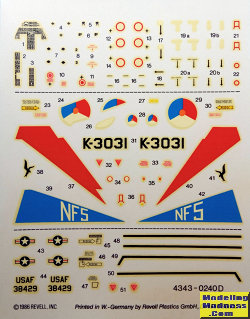
Revell 1/72 F-5A Freedom Fighter
| KIT #: | 4343 |
| PRICE: | $ |
| DECALS: | Two options |
| REVIEWER: | Spiros Pendedekas |
| NOTES: | Reboxed ESCI kit |

| HISTORY |
| THE KIT |
 This
is the 1986 Revell reboxing of the original 1983 ESCI mold. The specific
kit was a gift from good Dutch friend John vd Biggelaar, as he knows I
have an affection for old classic kits. It comes in a medium sized top
opening box, featuring a box art of a completed model in Dutch markings.
This
is the 1986 Revell reboxing of the original 1983 ESCI mold. The specific
kit was a gift from good Dutch friend John vd Biggelaar, as he knows I
have an affection for old classic kits. It comes in a medium sized top
opening box, featuring a box art of a completed model in Dutch markings. Transparencies
are well molded and relatively clear. Instructions are well done in the
form of a 6-page pamphlet, with the construction spread in 20 simple and
concise steps. Color callouts are given where applicable. Two
interesting schemes are provided, for a commemorative Dutch bird and for
a US Top Gun example. Colors are given in Revell codes and in generic
form. Apart from the expected yellowness, the almost 30yo decals are
sharply printed and look to be in usable condition, but, of course, you
can never know with old decals until you try them.
Transparencies
are well molded and relatively clear. Instructions are well done in the
form of a 6-page pamphlet, with the construction spread in 20 simple and
concise steps. Color callouts are given where applicable. Two
interesting schemes are provided, for a commemorative Dutch bird and for
a US Top Gun example. Colors are given in Revell codes and in generic
form. Apart from the expected yellowness, the almost 30yo decals are
sharply printed and look to be in usable condition, but, of course, you
can never know with old decals until you try them.| CONCLUSIONS |
September 2024
If you would like your product reviewed fairly and fairly quickly, please contact the editor or see other details in the Note to Contributors.